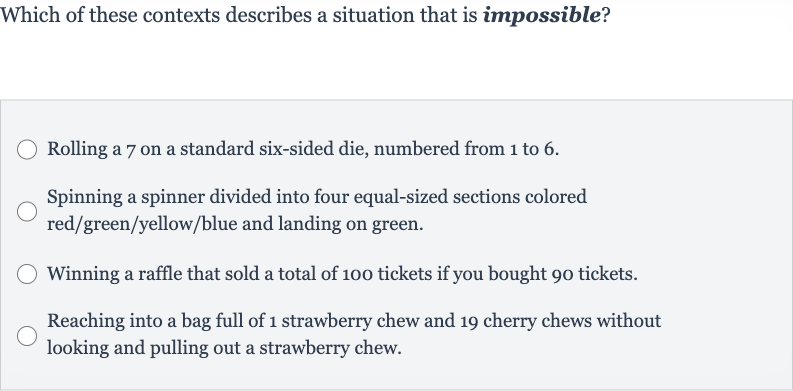AI tutor
Welcome to Bytelearn!
Let’s check out your problem:

Which of these contexts describes a situation that is impossible?Rolling a on a standard six-sided die, numbered from to .Spinning a spinner divided into four equal-sized sections colored red/green/yellow/blue and landing on green.Winning a raffle that sold a total of tickets if you bought tickets.Reaching into a bag full of strawberry chew and cherry chews without looking and pulling out a strawberry chew.
Full solution
Q. Which of these contexts describes a situation that is impossible?Rolling a on a standard six-sided die, numbered from to .Spinning a spinner divided into four equal-sized sections colored red/green/yellow/blue and landing on green.Winning a raffle that sold a total of tickets if you bought tickets.Reaching into a bag full of strawberry chew and cherry chews without looking and pulling out a strawberry chew.
- Evaluate Possibilities: We need to evaluate each situation to determine if it is possible or impossible.
- Rolling a : First, let's consider rolling a on a standard six-sided die, numbered from to . A standard six-sided die has only the numbers through , one on each face. Therefore, it is impossible to roll a .
- Spinning a Spinner: Next, we look at spinning a spinner divided into four equal-sized sections colored red/green/yellow/blue and landing on green. Since green is one of the colors on the spinner, it is possible to land on green.
- Winning a Raffle: Then, we consider winning a raffle that sold a total of tickets if you bought tickets. While the chances are high, it is still possible to win the raffle with out of tickets.
- Reaching into a Bag: Finally, we evaluate reaching into a bag full of strawberry chew and cherry chews without looking and pulling out a strawberry chew. Since there is a strawberry chew in the bag, it is possible to pull it out, even though the chances are lower than pulling out a cherry chew.
More problems from Interpret confidence intervals for population means
QuestionGet tutor help
QuestionGet tutor help
QuestionGet tutor help
QuestionGet tutor help
QuestionGet tutor help
QuestionGet tutor help
QuestionGet tutor help
